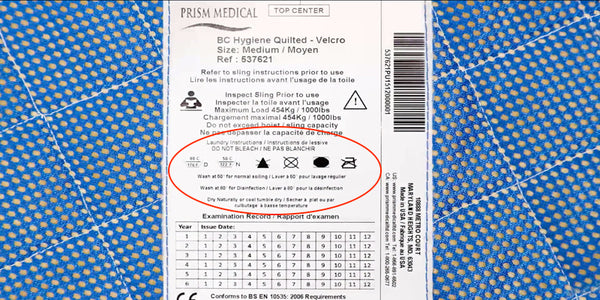Cleaning and Disinfecting Assistive Devices and other Medical Products

Cleaning and Disinfecting Assistive Devices and other Medical Products
With the increasing number of patients being cared for in ambulatory-care (i.e. outpatient facilities) and home settings, it is essential to understand the procedures of proper cleaning and care of medical products and assistive devices for a safe patient environment. Infection control includes proper hygiene, cleaning, disinfection of equipment, sterilization, and the safe storage of these devices. For more detailed information, please follow the manufacturer's instructions on the product label and/or user manual.
Equipment housings and hard surfaces:
- Protective plastic covers, motor housings, carry bars, mobile, and stationary lifts, and other hard surfaces may be cleaned and disinfected with a soft cloth saturated with most common non-abrasive cleaners or sanitary wipes including isopropyl alcohol (70% ethanol, 45% isopropanol).
- Do not allow moisture to get inside the housing, electrical components, or moving mechanical parts.
- Cleaning agents containing phenol and chlorine bleach are not recommended, as this could damage aluminum and plastic materials.
Lift straps and fabrics including lifting slings and belts:
- Virox RTU (Ready-to-Use), a commercially available hydrogen peroxide cleaning solution is approved for cleaning, wiping down, and disinfection of lift straps and fabrics.
- If additional disinfection is needed, 70% ethanol, 45% isopropanol solution should be used.
- Never use products containing chlorine or bromine.
- Allow lift straps to dry completely before raising back up into the motor housing.
All cleaning:
- Follow the cleaning agent manufacturer's instructions for use.
- A color change in lift straps, sling fabric, or belts may indicate contact with chlorine or chlorine-based bleach, and the affected item should be replaced or discarded. Exposure to such products will void the warranty.
Sling care and laundering:
- The sling should be inserted into a washing/laundry bag prior to being placed into the washing machine to prevent any unusual wear and tear of the sling by the agitator and/or other parts of the washing machine.
- Use mild detergent with a pH of 7-11.
- Set the washing machine to warm wash/cold rinse cycle.
- Washing for disinfection should be at 176°F / 80°C.
- Washing for normal cleaning should be at 122-140°F / 50-60°C.
- Tumble dry on air/fluff cycle only, no heat, or hand dry. Do not dry on steam pipes, conventional heaters, wood stoves, or other similar devices.
- Do not dry clean.
- Do not use rinse/fabric softener.
- Do not use products containing chlorine or bromine. Exposure to such products will void the warranty. A color change in sling fabric or belts may indicate contact with chlorine or chlorine-based bleach. If a sling has been exposed to chlorine-based bleach it is recommended that the sling be discarded and/or replaced.
- After washing and drying the sling should be inspected. If any sign of wear, tear, fraying or damage is found the sling should be discarded.
The washing instructions and symbols are found on the sling serial number label:

Surface cleaning single client (disposable) and other fabrics:
- Sling bodies, loops, and belt surfaces may be wiped clean of surface soiling with a soft cloth saturated with most common non-abrasive cleaners or sanitary wipes that do not contain chlorine or bromine.
- Virox RTU (Ready-to-Use), a commercially available hydrogen peroxide cleaning solution, is approved for surface cleaning and disinfecting fabrics.
Disposable materials facilitate infection control efforts
- Single Client (Disposable) fabrics are water resistance treated to assist surface cleaning, should never be laundered, and discarded and replaced if they show any sign of heavy soiling, wear, tear, fraying or damage. This prevents the spread of multi-resistant and other types of contagious bacteria
Positioning and sliding sheets
- Sliding and patient positioning sheets can be washed in 140-194°F / 60-90°C
- Tumbler-drying at low temperature. Do not use rinse/fabric softener.
- Do not dry clean.
Sources:
- Care Instructions for Handicare's SystemRomedic products, Handicare AB, 2014
- Cleaning and Disinfecting PRISM Medical Products, Prism Medical Ltd, 2016
- Disinfection of Healthcare Equipment, Centers for Disease Control and Prevention (CDC), 2008
- Division of Healthcare Quality Promotion (DHQP)
- VIVA University Research and Blog Administration
Comments 0